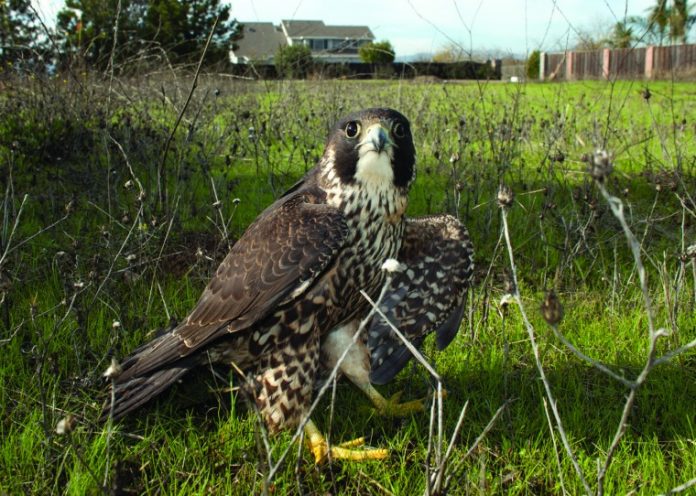’Twas the fortnight before Christmas when Steve Johnson was putting up festive Christmas decorations outside his home in San Martin and witnessed something strange going on in the field next door. Walking over, he discovered an injured juvenile peregrine falcon on the ground, with some turkey vultures circling it with curiosity. Steve rescued the 15-inch long raptor and brought it to the Wildlife Education and Rehabilitation Center.
Exactly how the falcon was disabled is unknown, though it likely may have hit an object or building while diving in on its prey. The bird had no wounds or bleeding but its left wing was severely drooping and the joint was badly bruised, with what WERC staff feared to be a fracture. It was examined by Dr. Laura Bellinghausen and X-rays showed that the bones in the elbow were dislocated, which is extremely unfortunate for a bird that relies on absolutely perfect flight for long-term survival in the wild.
To prevent further injury and to aid healing, the wing is kept wrapped and the falcon is on twice daily pain medication. However, it is sadly evident that the grave damage to the wing is permanent and this falcon can never be released. He would die of starvation because he would only able to fly a short distance or not at all. But because the young peregrine appears to be in good health despite his damaged wing and shows a calm temperament, the handsome bird with distinctive black “sideburns” just may be suitable for placement at a licensed wildlife/nature facility as an educational animal.
This falcon’s circumstances are almost identical to that of Horus, the peregrine falcon that became WERC’s educational wildlife ambassador seven years ago. Horus, too, is a local bird who was less than 1-year-old when he permanently injured his left wing in a collision with some solid object. Horus now visits classrooms, libraries and public events, giving a close-up view of this amazing bird and providing a link between humans and wildlife, helping us to understand their place in our world.
The natural history of the peregrine falcon tells a fascinating and unique story. Did you know it is the fastest bird in the world, reaching diving speeds of more than 200 miles per hour? Their bodies are built for speed: Tiny yellow cones inside a falcon’s nostrils direct the powerful airflow away from the nostrils, allowing the bird to breathe more easily while steep-diving. (An interesting fact: Aeronautic engineers wondering how the peregrine could withstand the force of air at high speeds, used their research to successfully fashion comparable cones on jet engines.)
Using much the same form as a speeding bullet, the peregrine folds its wings against its body and hurtles downward in a steep dive (called a stoop) to knock out a flying bird – the almost exclusive prey of the falcon – and snatch it while still in the air. Their feathered prey ranges from birds many times larger than themselves, such as sandhill cranes, to birds much smaller, such as hummingbirds. In the city, pesky pigeons are a favorite cuisine for the peregrine; in the countryside and by the coast, gulls and ducks are a dining delicacy (hence the peregrine’s common misnomer, “duck hawk”). Surprisingly, peregrines also prey on bats, those flying mammals that maybe look like a bird in the darkening sky.
Peregrine falcons are very adaptable birds and can be found on every continent except Antarctica. They prefer wide-open spaces and near coasts but reside everywhere from cold tundra to hot deserts. Though peregrines live year-round in California and the western United States and Mexico, other peregrines have one of the longest migrations of any North American bird, wintering in South America and summering (breeding) in Alaska and northern Canada, thus its name, Falco peregrinus, which means “wandering or pilgrim” falcon.
Peregrines must be on the lookout for the eagles and great horned owls that prey on them and their young, but humans pose a much greater danger to their survival. For ages, people have killed them and taken their young for falconry and sport hunting. But the most lethal threat came more recently – their near-extinction from poisoning from the pesticide DDT. Fortunately, before it was too late to save the peregrines, DDT was banned in 1972 and the species is making a comeback. However, it remains relatively uncommon in the United States – and has basically disappeared from the eastern United States – and is federally listed as threatened.
This peregrine falcon has been given the fitting name “Comet” both because these birds are streakers in the sky and, because it was rescued during the holiday season, after one of Santa’s high-flying reindeer.








